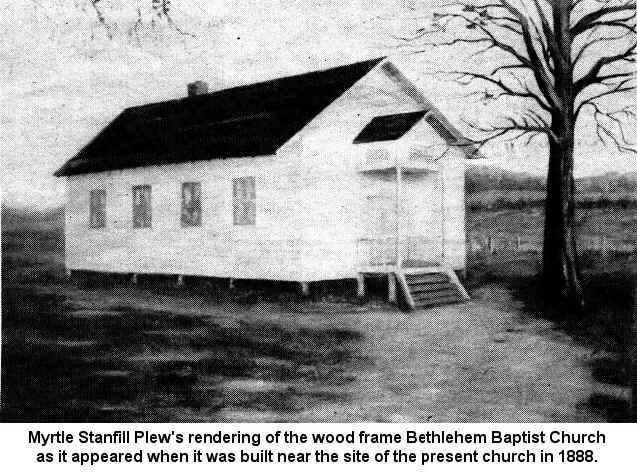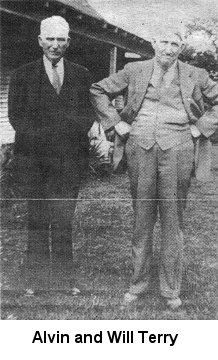FNB Chronicles
It is difficult for most of us to envision 162 years of history let alone realize that one institution, one church, could endure all the pressures of a changing society to remain a cornerstone in the development of a community and a county which were to come into being long after its establishment. But such is the history of the Bethlehem Baptist Church, which was founded 15 years before the state issued a charter to create Scott County and a full 83 years before the emergence of the town of Oneida.

"Oral testimony" reveals that the church was founded about 1834 in the Buffalo Creek section, as a group of people came together for services in the home of one of the church members. The oldest surviving document, however, is dated 1837 and grants a woman (ELIZABETH STEPHENS) admission into the church. At that time, Buffalo Creek was a part of Campbell County, as was still the case five years later when the oldest, regularly-kept church records were first being documented in 1842.
What is known about the beginnings of the Bethlehem Baptist Church is that JAMES LAY was the first pastor and that the organizers included SAMUEL OWENS, JONATHAN RICHARDSON and SAMUEL PREWET, who, incidentally, is listed as the church’s first clerk. There were 21 members.
The year 1842 is of particular importance in the church’s history and is marked by two rather momentous events. First, 1842 saw the establishment of the church’s first meeting house, which was located at the head of Buffalo Creek, in the same general vicinity of where the Pine Hill Baptist Church is presently situated.
That same year the church withstood one of its most traumatic periods, as an almost even split occurred in the congregation over one of the articles of faith of the Baptist doctrine. "There were 15 on one side and 16 on the other," said the late Pastor ROY BLEVINS, "and the dispute was over the Fifth Article of Faith: the final perseverance of saints or ‘once in grace, always in grace’".
|
Bethlehem
Baptist Church |
|
| 1834 – | James Lay |
| 1842 – | Reubin Bridges |
| 1843 – | John Chitwood |
| 1844 – | A. R. Childers |
| 1845 – | Bro. Manner and Bro. Webb |
| 1846 – 1864 | Unknown |
| 1865 – | John Goad |
| 1866 – 1870 | C. C. Yuner |
| 1871 – | James Litton |
| 1872 – | James McDonald |
| 1872 – 1873 | Jonathon Chitwood |
| 1874 – 1881 | G. C. Duncan |
| 1882 – 1888 | D. L. Acres |
| 1888 – 1889 | G. W. Cecil |
| 1890 – 1891 | Jonathan Chitwood |
| 1892 – | G. W. Cecil |
| 1893 – | W. R. Hamby |
| 1894 – | R. C. Cecil |
| 1895 – 1896 | G. C. Duncan |
| 1897 – 1899 | G. M. Davis |
| 1900 – | W. R. Hamby |
| 1901 – | John Stanley |
| 1902 – | J. H. Sanders |
| 1903 – | John Blevins |
| 1904 – 1905 | T. D. Carbin |
| 1906 – 1912 | R. C. Cecil |
| 1913 – | A. M. Gregory |
| 1914 – 1916 | J. M. Chambers |
| 1917 – 1919 | A. M. Gregory |
| 1920 – | E. Daugherty |
| 1921 – | Sherman Watson |
| 1922 – | J. S. Garrett |
| 1923 – 1929 | B. R. King |
| 1929 – 1932 | Rubin Jones |
| 1932 – 1934 | J. S. Garrett |
| 1934 – 1935 | John Blevins |
| 1935 – 1937 | J. S. Garrett |
| 1937 – 1984 | Roy Blevins |
| [1984 – 1988] | [John L. Shepherd, Jr.] |
| 1988 – 1992 | Clyde Martin |
| 1994 – | Lon Chenowith |
The majority, the 16 members, stayed with the Bethlehem Baptist Church, while the splinter group of 15 is believed to have taken up with the emerging Freewill Baptist Church doctrine and established their own church, possibly in the area which is now known as the Foster Crossroads section of the county.
The late WILL LITTON, a faithful member who resided in the area where the Litton Family Cemetery is located, recounted that in the mid- to late-1800s, the Bethlehem Baptist Church was one of only a few in this area and that people came from miles around to attend the monthly service.
LITTON told of a Rock Creek, Ky. family who traveled by horse to his home, arriving on a Friday. The following morning, the LITTON family and their Kentucky visitors would begin the long trip to the head of Buffalo Creek for services, remaining overnight and returning home on Sunday evening. Then Monday morning, the Kentuckians would start for home.
In 1869 the church was moved from the head of Buffalo Creek (Pine Hill) to the waters of Pine Creek, in the vicinity of where the Oneida City Park is now located. The building was also shared by the Methodist Church and the United Baptist Church. Rev. BLEVINS indicated that the move apparently followed a general shift in population in Scott County at that time, which paralleled the construction of the railroad through the county (beginning in the early 1860s).
Although it would be a full 48 years before residents of this area obtained a (city) charter from the state of Tennessee, the community which was to become the town of Oneida was rapidly emerging, due mostly to the establishment of the railroad.
Prior to that move, the Bethlehem Baptist Church, like many other long-established institutions of the era, apparently fell victim to the Civil War. While virtually flawless church records date back to 1842, there was a three year period during the Civil War when no records were kept. It is speculated that church members, divided over the conflict, may have chosen to suspend services until the war’s end.
Another relocation of the church came in 1888, as a wood frame building was erected on a small lot facing Chester Street, adjacent to the present location.
Property for that church building was donated by Judge W. A. "Will" TERRY, who served as Sunday School Superintendent for a number of years. W. A. TERRY desired the Bethlehem Church have the first opportunity to purchase the land on which he, his daughter and son-in-law, JOHN and ESTELLE MOORE, had homes. This became a reality when the MOOREs decided to move to Florida in 1976, The church became the owner of the property, the MOORE home was moved and became the parsonage.
For 93 years the church has remained in this location, undergoing countless remodeling and building projects. Because of the huge oak trees that dominated the site, the locale and, indeed, the church itself came to be referred to as Oak Grove.
When ROY BLEVINS answered the call to pastor the Bethlehem Baptist Church in 1937, there were not quite 100 members of the Sunday School housed in a structure which measured 80-feet by 36-feet. The outside of the church was faced with weatherboard, while the inside was ‘sealed". It was one of the oldest and largest churches in Scott County.
Within a year after the 33-year-old ROY BLEVINS became pastor, Bethlehem Baptist Church began to experience a period of growth which has yet to cease. And, along with the growth of the membership, the church building itself began to undergo a series of changes, enlargements and additions.
The first major addition to the church came in 1938 when the entire building was "jacked up" and a basement was dug to house classroom space. Then, over the years, the building’s exterior was brick veneered; the main auditorium was lengthened, first on one end and then the other; a west wing was erected, a two-story addition which changed the entire appearance of the church; and, then a three-story east wing was built. The lengthening of the auditorium, coming as it did in two separate stages, saw a baptistery constructed in the choir loft and the designing of a modern vestibule. The most modern addition at that particular church site came when a fellowship hall was constructed on the church grounds to accommodate church-related social activities,
 On
December 20, 1981, a full 147 years after it was founded, Bethlehem Baptist
Church dedicated its new structure, which is located adjacent to the old church
site,
On
December 20, 1981, a full 147 years after it was founded, Bethlehem Baptist
Church dedicated its new structure, which is located adjacent to the old church
site,
Bethlehem Baptist Church has reached out to other communities and helped establish other churches. Churches organized by its extended arm were Cave Creek Baptist Church (Pulaski County, Ky,), 1845; Pine Creek Baptist Church, 1879; Second Bethlehem Baptist Church, 1922; Hazel Valley Baptist Church, 1932; one in Muncie, Indiana; Foster Cross Roads Baptist Church, 1940; and West Oneida Baptist Church, 1945.
The first record of Sunday School was recorded on December 10, 1932 with the following appointed officers: W. A. TERRY, Superintendent; STERLING CROSS, Assistant Superintendent; and OSCAR LITTON, Secretary/Treasurer. The elected teachers were: W. E. DUNCAN, Men’s Class; Mrs. J. S. SMITH, Ladies’ Class; CALVIN HUMAN, Advance Class; W. C. LITTON, Intermediate Boys; MATTIE LEE JONES, Intermediate Girls; LELA RAUSE, Junior Girls; Stella Coffey, Junior Boys; and Dessie Lindsey, Children’s Card Class.
"Ministry is the heart of all we do at Bethlehem," said the Rev. [omitted], the present pastor. "We seek to be available to touch lives for the Gospel through every means. Our yearning is to see people of all ages come to faith in Jesus. We try to minister to families and strengthen family life through our bus ministry; ‘Young at Heart" senior ministry; Musical Mondays, a training and musical program time for elementary school children; our food and clothes closets; and our walking track and ball fields.
"To God be the Glory for all He has done for and through Bethlehem Baptist Church."
FNB Chronicle, Vol. 8, No. 1 – Fall 1996
First National Bank
P.O. Box 4699
Oneida, TN 37841
(p8-9)
![]() This
page was created by Timothy
N. West and is copyrighted by
him. All rights reserved.
This
page was created by Timothy
N. West and is copyrighted by
him. All rights reserved.